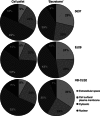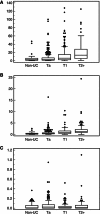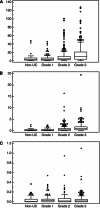Combined proteome and transcriptome analyses for the discovery of urinary biomarkers for urothelial carcinoma
- PMID: 23591195
- PMCID: PMC3658509
- DOI: 10.1038/bjc.2013.157
Combined proteome and transcriptome analyses for the discovery of urinary biomarkers for urothelial carcinoma
Abstract
Background: Proteomic discovery of cancer biomarkers in body fluids is challenging because of their low abundance in a complex background. Altered gene expression in tumours may not reflect protein levels in body fluids. We have tested combining gene expression profiling of tumours with proteomic analysis of cancer cell line secretomes as a strategy to discover urinary biomarkers for bladder cancer.
Methods: We used shotgun proteomics to identify proteins secreted by three bladder cancer cell lines. Secreted proteins with high mRNA levels in bladder tumours relative to normal urothelium were assayed by ELISA in urine samples from 642 patients.
Results: Midkine and HAI-1 were significantly increased in bladder cancer patients, with the highest levels in invasive disease (area under the receiver operating characteristic curve 0.89 vs non-cancer). The urinary concentration of both proteins was too high to be explained by bladder cancer associated haematuria and most likely arises by direct tumour secretion.
Conclusions: This 'dual-omic' strategy identified tumour secreted proteins whose urine concentrations are increased significantly by bladder cancer. Combined secretome-transcriptome analysis may be more useful than direct proteomic analysis of body fluids for biomarker discovery in both bladder cancer and other tumour types.
Figures





References
-
- Anderson N. The clinical plasma proteome: a survey of clinical assays for proteins in plasma and serum. Clin Chem. 2010;56:177–185. - PubMed
-
- Babjuk M, Oosterlinck W, Sylvester R, Kaasinen E, Böhle A, Palou-Redorta J, Rouprêt M, European Association of Urology EAU guidelines on non-muscle-invasive urothelial carcinoma of the bladder, the 2011 update. Eur Urol. 2011;59:997–1008. - PubMed
-
- Bolstad BM, Irizarry R, Astrand M, Speed T. A comparison of normalization methods for high density oligonucleotide array data based on variance and bias. Bioinformatics. 2003;19:185–193. - PubMed
-
- Bryan R, Wei W, Shimwell N, Collins S, Hussain S, Billingham L, Murray P, Deshmukh N, James N, Wallace D, Johnson P, Zeegers M, Cheng K, Martin A, Ward D. Assessment of high-throughput high-resolution MALDI-TOF-MS of urinary peptides for the detection of muscle-invasive bladder cancer. Proteomics Clin Appl. 2011;5:493–503. - PubMed
-
- Cauberg E, de Bruin D, Faber D, van Leeuwen T, de la Rosette J, de Reijke T. A new generation of optical diagnostics for bladder cancer: technology, diagnostic accuracy, and future applications. Eur Urol. 2009;56:287–296. - PubMed
Publication types
MeSH terms
Substances
Grants and funding
LinkOut - more resources
Full Text Sources
Other Literature Sources
Miscellaneous

